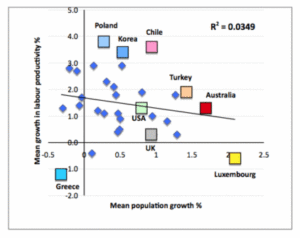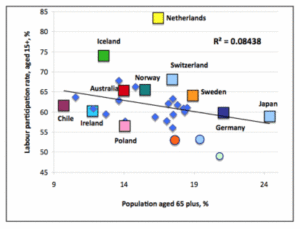The tenuous link between population and prosperity
Katharine Betts

The report claims such an increase will offset demographic ageing and boost economic growth, but neither claim is borne out by the evidence. The effects on ageing are both trivial and transient and, when economic growth is considered in per capita terms (and in terms of real welfare), the increase will certainly be detrimental.
The narrative of the Intergenerational Report is that the population will be growing (though this, it transpires, has little to do with ageing) and the larger population will need more services. This will put pressure on the budget. So how are we to build “a strong and resilient economy” and lay “the foundations for future prosperity”?
It is no surprise to readers of this report’s three predecessors that the answer lies in the odd trifecta of population growth, productivity and participation.
The scenario that the report focuses on is one where the total fertility rate remains at around 1.9, life expectancy is in the mid 90s and net overseas migration (NOM) is held at 215,000 per annum. The report is careful not to make too much of its immigration assumption, presenting the increase in percentage terms. If the absolute number for net migration remains constant, this percentage measure will always show an unthreatening decline year-on-year, because the base population on which it is calculated will have grown. (After all, the second person to step ashore from the First Fleet in 1788 increased the European population by 100%, and the 11th by only 10%.)
The report links migration with economic growth in a curiously indirect fashion:
“Lower levels of net overseas migration would lead to lower population growth rates over time and, therefore, lower economic growth.”
This is another way of asserting that high migration will increase aggregate GDP. Yes it will, but this has little to do with individual welfare. Here per capita GDP is the relevant measure.
GDP and well-being
The report projects a growth in aggregate GDP of 2.8% per annum over the next 40 years, but that of per capita GDP is projected at only 1.5%. So while the population will be growing briskly, the welfare of individuals will not be keeping pace with that of the economy as a whole. This may not concern the minority who profit from larger markets, but it will impact on voters.
Moreover the deep shortcomings of GDP as a measure of well-being are now all too well known; for example the misery that commuters experience stuck in traffic shows up as a positive for GDP (more petrol consumed, more costly wear and tear on vehicles), and the GDP takes no count at all of the drag that the congestion imposes on productivity. In contrast the State of Australian Cities report [2] predicts traffic congestion in the major cities will cost Australians A$20.4 billion a year by 2020 and stories [3] of its ill effects on productivity are commonplace.
The report also says, quite modestly, that migration “has an impact on the age distribution of the population” (because migrants tend to be younger when they arrive). Other authoritative government reports [3] find little support for the argument that high migration cures demographic ageing so a modest statement is prudent. But the scenario the authors have adopted is one of historically high migration (the first Intergenerational Report [4] assumed NOM of 90,000). Their subsequent justifications for their NOM of 215,000 in fact turn both on that of growth in aggregate GDP and the anti-ageing theme. (Yes, high migration will reduce the median age [5] by around five years – temporarily.)
The report’s scenario leads to a population growing from 23.9 million in 2015 to 39.7 million in June 2055. Were we to follow a similar scenario but with nil net migration the population in June 2055 would be 26.9 million [6].
The report proposes a population increase of 12.8 million above and beyond where natural increase would take us. To what end? In June 2014 the total population of Melbourne, Sydney, Brisbane and Adelaide was 12.6 million. The report does not explain how building the equivalent of all these cities again in just 40 years will enhance our productivity.
Given the infrastructure demands, it is not surprising that data from 32 OECD countries show no statistically significant association between productivity and population growth.
Calculated from ECD.StatExtracts for labour productivity and for population growth except for Australian population growth. The OECD defines labour productivity as GDP per hour worked. ABS data were used for Australia’s population growth rate as the OECD data had not been recalibrated in the light of the 2011 census OECD/ABS
Better that the trifecta of the three Ps were reduced to a duo of productivity and participation. High immigration may have no effect on productivity, as the figure above shows, or as Australian experience suggests, may reduce it.
And it can be irrelevant to participation.
The report projects that, as the population ages, labour-force participation rates will fall from their current levels of 64.6% to 62.4% in 2054-55. But in the youthful and prosperous 1960s rates were much lower [7]: 59.9%, for example, in August 1966.
This shows that labour-force participation can vary without necessarily affecting economic well-being and that it can be shaped by a range of factors other than demographics – for example, accessible childcare, employers’ willingness to hire women and older people, and cities that permit workers to get to work in a reasonable fashion.
It is therefore not surprising that evidence from comparable OECD countries shows no statistically significant association between the proportion of people aged 15 plus in the labour force and the proportion aged 65 plus.
Too much emphasis can be placed on the crude demographic measure of the proportion of a population of so-called working age: 15 to 64. Equally, too little can be made of the social, economic and policy factors that help or hinder labour-force participation.
As a figure provided in the original article of population on June 2014 by age, sex and other characteristics demonstrates [not reproduced here because it is dependent on colour coding – Ed], quite a few people aged 65 plus are in the labour force and many of those aged 15 to 64 are not.
Studying means attending full-time education, and people aged 25 plus who may be studying full-time are not shown. A person is said to have a profound or severe disability if they always or sometimes need help with one or more of three core activities: mobility, self-care and communication. Primary carers are people taking the main responsibility for someone who is profoundly or severely disabled.
Unemployment among people aged 15 to 24 is under-estimated as they have not been shown as unemployed if they are also in full-time education.
The figure also highlights the depend- ence of children and young people. No one under the age of 15 is in the labour force, and many of those aged 15 to 24 are full-time students not in paid work.
Indeed it is only in childhood that chronological age inevitably means dependence on others. Now that we are emancipated from the hyper-youthful populations of the past, more adults are freed from the unavoidable labour of caring for the young. They are freed for work, for building strong communities.
Source: The Conversation, 13 March 2015 https://theconversation.com/


[su_spacer size=”10″]
References:
[1] http://www.treasury.gov.au/PublicationsAndMedia/Publications/2015/2015-Intergenerational-Report
[2] http://www.infrastructure.gov.au/infrastructure/pab/soac/
[3] http://www.pc.gov.au/research/completed/population-migration
[4] http://archive.treasury.gov.au/contentitem.asp?ContentID=378
[6] http://www.abs.gov.au/ausstats/[email protected]/Lookup/3222.0main+features42012%20%28 base%29%20to%202101
[7] http://www.abs.gov.au/AUSSTATS/[email protected]/DetailsPage/6291.0.55.001Jan%202014?OpenDocument

Katharine Betts is a researcher In sociology, and is an Adjunct Associate Professor at the Swinburne University of Technology.



























